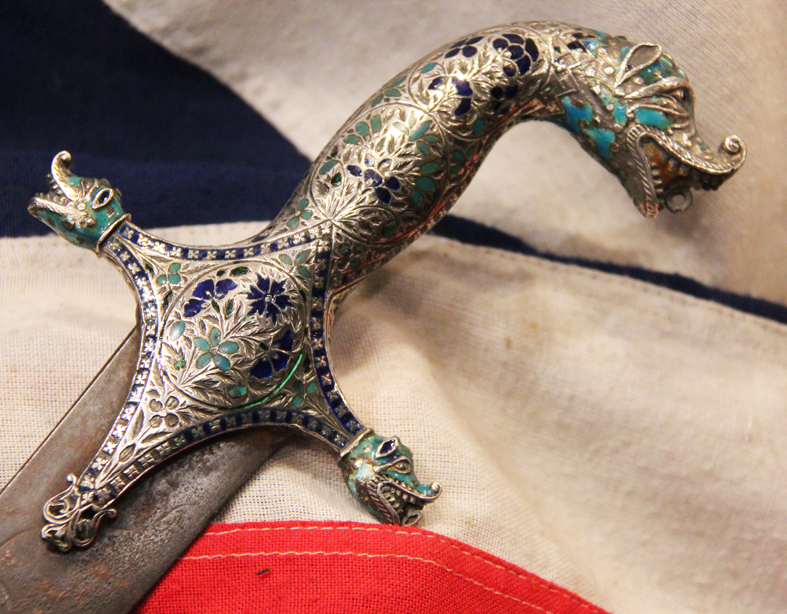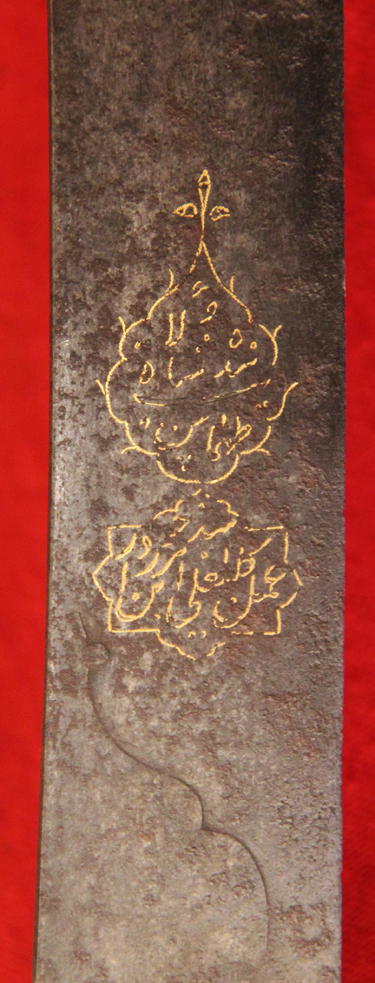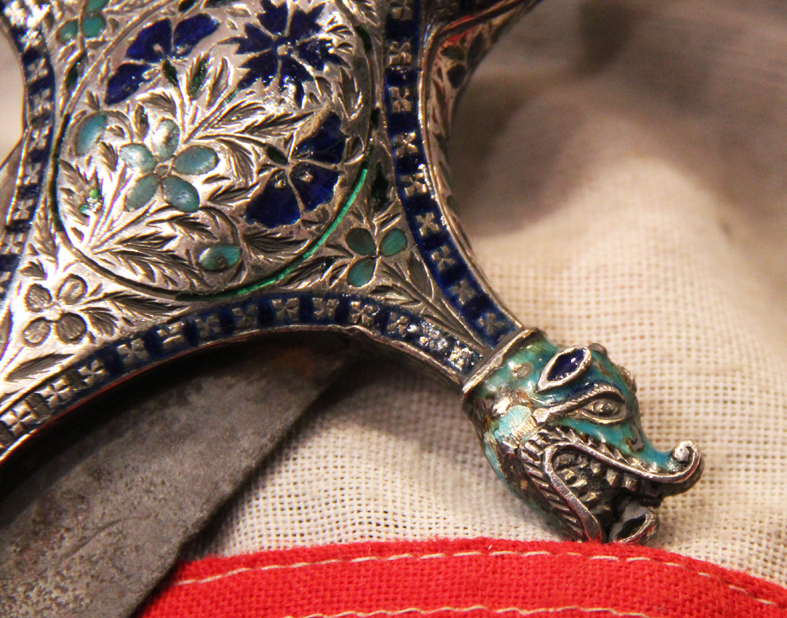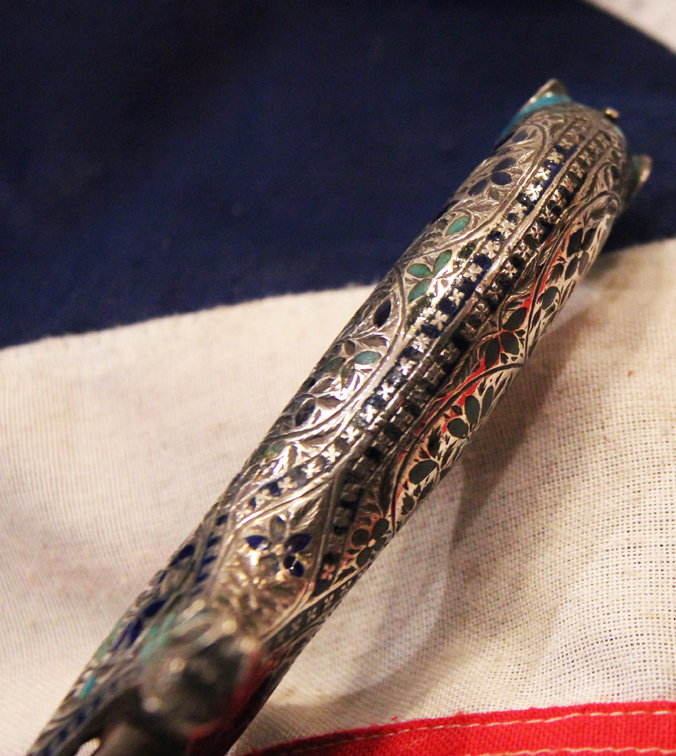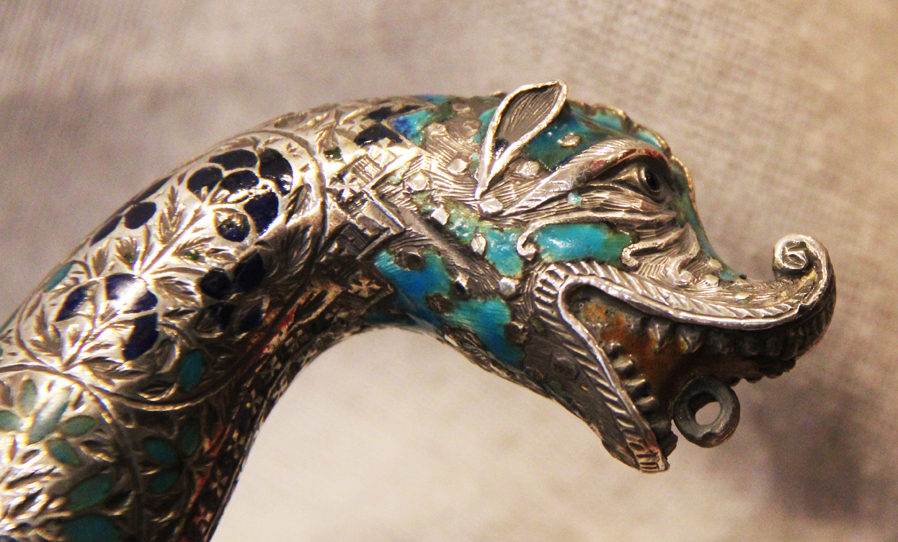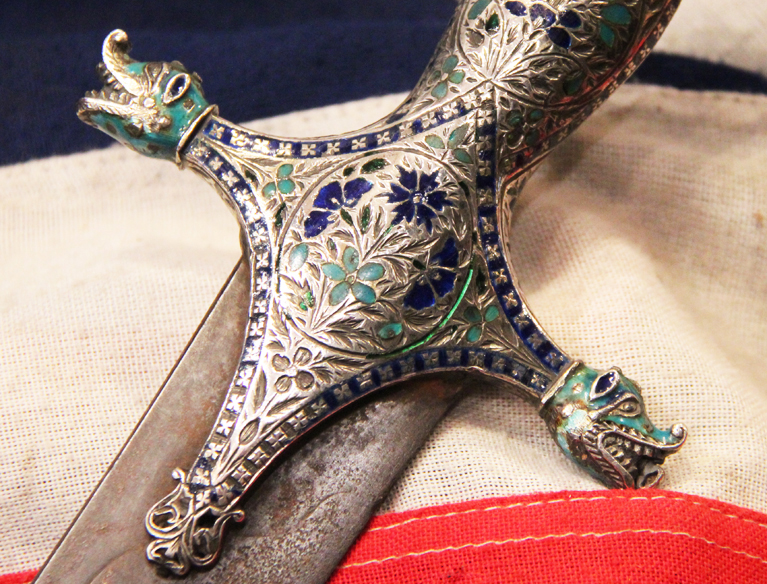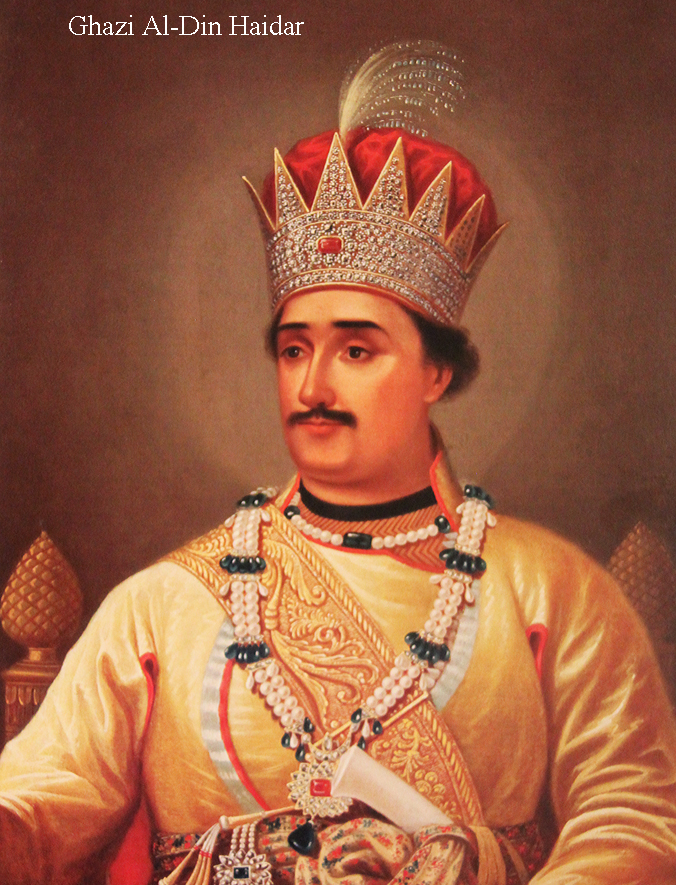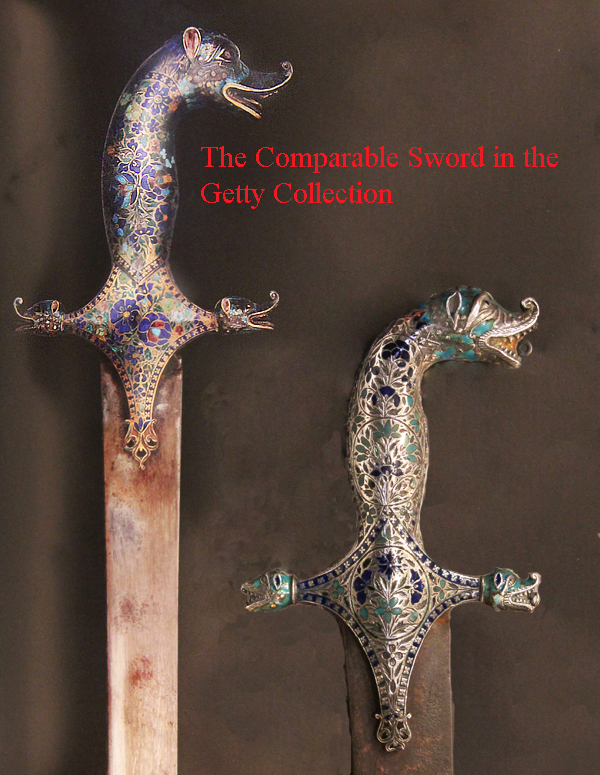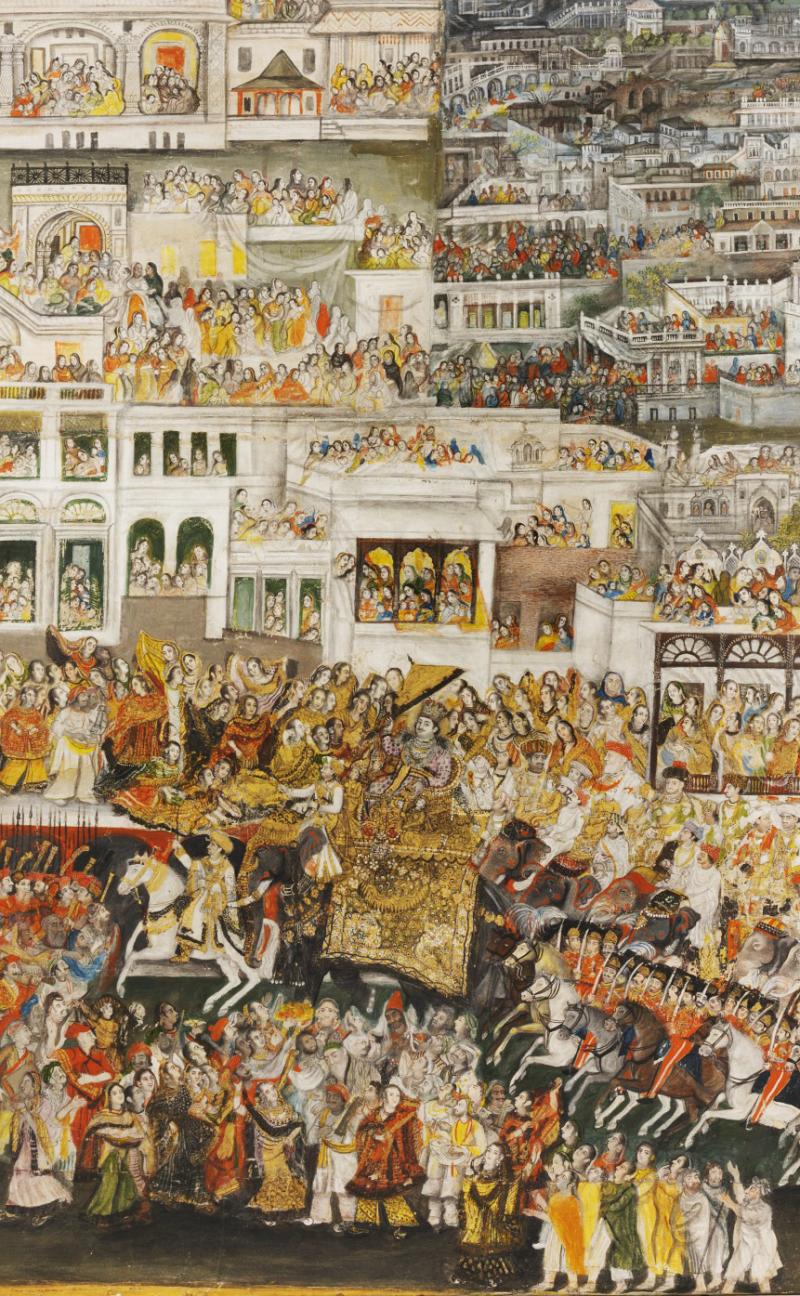Fabulous Museum Grade Sword 18th Century Damascus Wootz Steel, Mohammed's Ladder Pattern, & Stunning Solid Silver & Enamel Makara Hilt, The 'Palace of the Nawab of Lucknow’. Probably One of The Most Beautiful & Finest Indian Princely Royal Swords
This fabulous royal grade solid silver and enamel sword, with Lucknow distinctive enamel work of flowering plants interspersed with architectural vignettes, has just returned from a museum grade blade polish to reveal its obscured {through natural age} finest, crucible steel wootz Damascus blade, in the pattern of Mohammed's Ladder. Unsurprisingly, it now looks as fine and beautiful as it was when last used in the 18th & 19th century by such as the King of Oudh {Lucknow} Ghasi-ud-din, Haidar Shah
The ‘Mohammed’s Ladder’ Kirk Narduban Crucible ‘Wootz Damascus’ steel blade is truly breathtaking.
The Ladder of Mohammed is said to have enabled Mohammed to travel through the heavens, meeting various prophets and gaining access to the different levels of paradise. Muhammad's ladder thus symbolizes the connection between the terrestrial and spiritual worlds, representing spiritual elevation and proximity to God.
Which ultimately means, to many, this is the most desirable and likely rarest of all the early Indo-Persian crucible wootz Damascus steel blade designs, being of such a spiritual significance, as well as stunningly beautiful. Intriguingly it is still contentious, to specialist academics, as to how it was even made, as there is no clear agreed evidence or knowledge as to its extraordinary construction. There are two trains of thought but no undeniable agreement..
The museum grade conservation polish goes up to the gold cartouche, at the base of the hilt, and around the hilt langets. The small area of the gold cartouche has been left ‘as is’ intentionally. The potential very high risk of damage being created to the gold calligraphy by attempting to polish within the gold seal would be extremely dangerous to its integrity. It is only responsible to not take any even remote chance of damage to this fabulous and historical rare treasure.
A near identical pair to our sword, is another magnificent and rare example, Makara enamel hilted crucible steel bladed sword, is an exhibit in the world renown Getty Museum Collection in America {see a photo of the pair together side by side by comparison in the gallery}. Occasionally, surviving Lucknow swords of the silver and enamel Goat Head pattern can be found, used by lesser nobles of the Shah's court, but the mythical Makara silver and enamel hilted swords, apparently, were reserved for the Shah's sole and personal use, especially with the Mohommed's ladder blade.
A magnificent work of art, and the sword of a prince or king. It has a fabulous vibrant hues of brilliant blue and green through a painstaking champlevé and basse-taille enameling process. This process involves fusing coloured glass to metal at extraordinarily high temperatures to create a striking and durable outer layer that can withstand the test of time. This distinctive usage of blues and greens on the piece reinforces its origins in Lucknow, a renowned centre for the production of such sophisticated enamel artifacts. The fabulous wootz Mahommed's Ladder Kirk Narduban pattern Damascus blade, with a gold inscription and gold cartouches. In very good condition for age, the polychrome enamels are inlaid into the solid silver hilt, that is further decorated with three heads of the mythical beast, the Makara, including the pommel and both quillon ends, with just very minor enamel surface losses. One of the finest Lucknow Damascus swords you could find today, from the one time rulers of Lucknow, and most likely originated from the palace of the Nawab of Lucknow.
A Nawab was a Sovereign Prince and Governor of the Moghul Empire. An almost identical princely form of Lucknow Makara enamel silver hilted sword is in the Getty Research Institute, in LA, California. Centuries ago Lucknow emerged as one of the most important centres in the world for courtly crafts such as fine enamelling on silver.
It was the capital of the state of Oudh which was established in 1750. The flourishing arts scene was largely on account of the patronage of the local, supremely wealthy Nawabs of Oudh. By the mid-19th century, Lucknow was India's largest and wealthiest city. Lucknow Moghul daggers and swords, especially with Damascus blades, are considered to be some of the most valuable and desirable in the world of antique weaponry art. Representations of such are in the finest collections, such as the British Royal Collection, The British Museum and the Getty Museum.
The mythical Makara;
Dwelling in the Indian Ocean, the Makara is traditionally looked upon as a powerful deity, which was capable of harming or guarding seafarers, depending upon its whims. Many scholars naturally assume that the tales of the Makara are nothing more than myths based upon ancient eyewitness accounts of Indian elephants swimming off the coast of India, as they are sometimes known to do. Until 1719, the subah of Awadh was a province of the Mughal Empire administered by a Governor appointed by the Emperor. Persian adventurer Saadat Khan, also known as Burhan-ul-Mulk, was appointed Nizam of Awadh in 1722 and established his court in Faizabad, near Lucknow.
Many independent kingdoms, such as Awadh, were established as the Mughal Empire disintegrated. The third Nawab, Shuja-ud-Daula (r. 1753-1775), fell out with the British after aiding the fugitive Nawab of Bengal, Mir Qasim. Roundly defeated at the Battle of Buxar by the East India Company, he was forced to pay heavy penalties and surrender parts of his territory. Awadh's capital, Lucknow rose to prominence when Asaf-ud-Daula, the fourth Nawab, shifted his court to the city from Faizabad in 1775. The British East India Company appointed a resident (ambassador) in 1773 and by early 19th century gained control of more territory and authority in the state. They were, however, disinclined to capture Awadh outright and come face to face with the Maratha Empire and the remnants of the Mughal Empire. In 1798, the fifth Nawab Wazir Ali Khan alienated both his people and the British and was forced to abdicate. The British then helped Saadat Ali Khan take the throne. He became a puppet king, and in a treaty of 1801, yielded large part of Awadh to the East India Company while also agreeing to disband his own troops in favour of a hugely expensive, British-controlled army. This treaty effectively made the state of Awadh a vassal of the East India Company, although it continued to be part of the Mughal Empire in name until 1819. The treaty of 1801 proved a beneficial arrangement for the East India Company as they gained access to Awadh's vast treasuries, repeatedly digging into them for loans at reduced rates. In addition, the revenues from running Awadh's armed forces brought them useful returns while the territory acted as a buffer state. The Nawabs were ceremonial kings, busy with pomp and show. By the mid-nineteenth century, however, the British had grown impatient with the arrangement and demanded direct control over Awadh.
In 1856 the East India Company first moved its troops to the border, then annexed the state for alleged maladministration. Awadh was placed under a chief commissioner Sir Henry Lawrence. Wajid Ali Shah, the then Nawab, was imprisoned, then exiled by the East India Company to Calcutta. In the subsequent Indian Rebellion of 1857, his 14-year-old son Birjis Qadra, whose mother was Begum Hazrat Mahal, was crowned ruler. Following the rebellion's defeat, Begum Hazrat Mahal and other rebel leaders sought asylum in Nepal. Ghazi-ud-Din Haidar Shah became Nawab Wazir of Oudh on 11 July 1814 after the death of his father. In 1818, under the influence of Warren Hastings, the British Governor of the Presidency of Fort William (Bengal), he declared himself as the independent Padshah-i-Awadh (King of Oudh). This sword would likely have been part of his treasure.
The story of the the wonders of the creating of these blade goes back at least 2400 years. The possibly first indirect reference to crucible steel appears in the writing of Ctesias of Cnidu, a Greek physician at the court of the Persian King Artaxerxes II (404 BC - 398/397 BC) he wrote several (lost) books about Persia and India. St. Photios the Great (Ecumenical Patriarch of Constantinople from 858 to 867 and from 877 to 886) quoted from Ctesias books in the 9th century AD or about 1300 years later. From this we know of two wonderful if not magical swords of (maybe) Indian iron that Artaxerxes gave to Ctesias.
Going back 1700 years. Such as was written by Zosimos (a. 350 AD - ca. 420 AD) who was born in Panoplis (present-day Akhmim in the south of Egypt). He worked as an early alchemist in Alexandria and has written in fine detail. Some of his writings have survived. As far as crucible steel is concerned, he states:
"The tempering of Indian Iron: Take 4 pounds of soft iron, and the skins of myrobalans, called elileg, 15 parts; belileg, 4 parts; and two parts of glassmakers magnesia. Then place it into a crucible amd make it level. .... Put on the charcoal and blow the fire until the iron becomes molten and the ingredients become united with it. ... Such is the premier and royal operation, which is practiced today and by means of which they make marvellous swords. It was discovered by the Indians and exploited by the Persians".
Two paintings in the gallery {for historical information only};
1} Ghasi-ud-din, Haidar Shah Nawab of Oudh (in power from 1814 to 1818), and was subsequently made the first King of Oudh (1818-27). Its possible he may be holding this sword when he sat for this portrait in 1818
2} The Procession of Ghazi ud-Din Haider Shah through Lucknow
No scabbard.
Code: 22605
38995.00 GBP


